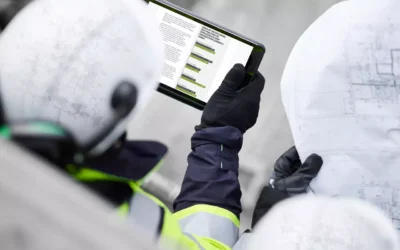“Vision without action is a dream. Action without vision is a nightmare.”
Honda Soichiro, Founder, Honda Motor Company
InEight’s second annual Global Capital Projects Outlook report came out earlier this year. The report draws from industry insights that the company gathered through a research program consulting with over 300 of the world’s largest capital project owners, including construction industry professionals across the Americas, Europe and Asia Pacific.
And the news was good. In fact, the report found that 96% of respondents were optimistic about their business’ growth prospects for the upcoming 12-months, and most owners and contractors stated that technology and investment were still highly-valued. The report also showed that digital technologies enabling accurate data collection, analytics and insights were perceived to offer many opportunities for growth.
However, almost 93% of respondents also said that their experience with technology change management could use some improvement, signaling a likely need for a more sophisticated approach to not only technology transformation, but for general organizational transformation as well. Of particular concern to respondents were items around uneven or sporadic implementation practices and the effects it had on real people and being able to drive consistent success for those people.
To explore some solutions to these challenges, Andrew Harris, Vice President of Sales for InEight Asia Pacific and Japan, sat down with a special panel of industry pros from the fields of organizational and human-centric change management, and project management to discuss how these fields underpin successful organizational transformation.
Experts included Anna Ayoub, Head of Organizational Change Management Function at Fusion5, Martin Coetsee, Global Head of IT for DRA Global, and Baris Ozdemir, Director of Client Solutions for InEight APAC. What follows are the highlights and key insights of that conversation.
The Driving Need to Invest in Tech Change Management
There is a saying that where there is uncertainty, there is also opportunity. This sentiment seems to be reflected in the wave of honest reassessment going on in the industry around how technology can help workforces become more productive, efficient and effective at what they do. This, in turn, is causing many construction businesses to take new stock in their organizations’ processes, people and technology.
The result? A maturing, pragmatic approach to digital transformation and change management is being adopted, putting people at the center of everything as companies try to understand how best to transform their organizations in a way that today’s technology will support, yet that still blends well with what real people need and even demand.
Distinct from such movements of the past seems to be technology’s growing ability to support an aspect of broader organizational change. And while the industry can boast a lot of experience in the capital project sector itself, there is also such a trend reflected throughout other industries, signaling real sea change.
The thinking is that if an organization is taking a technology-led approach, there’s going to be a very high chance of adoption failure. Therefore, if they take a people-centric approach, they’re going to see much higher success rates.
But what are the right ingredients for successful, people-centric change? Considering that, according to McKinsey & Company, a staggering 70% of digital transformations are perceived by those involved as failures, understanding what’s necessary for success is crucial.[1]
This is one reason why the value of good change management can never be overstated. After all, even if you have an excellent product that does everything that anyone could ever wish for with all the bells and whistles possible, without proper end-user support on that product, your implementation will fail.
On an up note, recent Gartner research reports that if a business has a collaborative change management process, it’s going to increase the adoption success rate by 24%.[2] That collaboration boost also seems to take sponsorship from the top right from the start. This is because having leadership that embraces change visibly shows team members that such change is important to the organization and illustrates the difference it’s going to make.
But what is collaborative change, what does it look like, and where do you start?
Five Critical Elements of Successful Change Management
Fusion5 has found out what many companies are currently learning; that adoption success may come down to five key elements, that, if achieved, can help predict successful outcomes for digitalization.
- Have a compelling story for change. What is it that you are trying to achieve and why? Can you also answer each team members’ question of “what’s in it for me?” You must also be able to link their contribution to their individual personal development, increasing their market value by continuing to help them learn new ways to do their jobs. This step can make or break the transformation itself, its longevity and its realized value.
- Understand stakeholders and the impact on them. You must identify who your stakeholders are, and that means all of them; even those whom you think may not be impacted. Think about them and write them down, then complete an impact assessment plan. Leave no one out!
- Create the actual plan for change. What are the communication engagement activities that you will need to take people on a successful change journey? Will it include your sponsors? Remember, be as specific as you can and visualize your desired outcomes clearly.
- Assess your readiness for change. This refers to the actual, physical training and learning that will need to take place. How are you, literally, going to train your people? What supporting materials are you going to give them, i.e., videos or on-screen guidance? How are you going to support your users once the system is live?
- Conduct adoption check-ins. After your go-live date, you must have check-ins lined up to keep a finger on the pulse of what’s happening, where there are issues, and what’s being done to solve those issues. Why? Because without adoption check-ins, it will be very difficult to get an accurate picture of what is truthfully going on with your people and how they are really doing.
Staying the (Holistic) Course to Success
In DRA’s experience, a holistic, layered approach has been the best way to go and includes looking at the different motivations within a set of ideal transformation principles. For example, they were looking to have the principle of one set of project truth, meaning one source, one data set that cut across their entire organization.
How and why does this approach work? Every time DRA does a product selection or embarks on a project, they go and check that principle they selected and make sure everyone is aligned within it. This gives the company big-picture guidance toward true digitalization.
Speaking to the more human-centric side of things, DRA has also found that when you deal with people one-to-one on projects, you must also make a real connection with them. There is a need to understand where they’re coming from while still having empathy for them, understanding their perspectives and challenges. Why does this matter so much?
Because only when you do these things will you really start to take them on the journey with you. Conversely, if a forced approach is taken, it will be much harder to understand disruptions in their world, and how can you help solve those disruptions.
On the other end of the spectrum, you must also be able to honestly call out the things that may go wrong. Because things will go wrong. It takes a certain amount of courage to flag when things are not working, and a pivot is needed. But the earlier you can act decisively, the more you’re going to save your organization from over-funding failing decisions.
Remember, a digital transformation is about many elements being transformed, and if your people don’t transform too, the processes will not be followed, and the technology will not be utilized. Therefore, it’s critical to know, at all times, where you are.
For instance, maybe you’re not documenting your current situation very well, or communicating it effectively enough. That may be a red flag that something is not working, and you’ll want to assess what is going on. Perhaps you’ll need to increase the capability of certain individuals or reduce their workload.
What if you’re simply seeing a drop is desire or ability? You may want to take a pause because your organization may not be ready for a particular amount of change at the rate you’re going. It may be time to focus more on critical pain points, then bring other changes forward after that.
Expect Change Fatigue, But Remain Focused
Change fatigue can happen and, even more truthfully, it probably will. Avoiding the worst of it centers around ensuring that you can see every single aspect, every single project that you have going on in the organization and that you do your best to understand if it is too much.
Are you over-impacting your sales team, for example, or your operation and delivery teams? Perhaps your builders on site are getting 10 different changes all in the same month; is that sustainable and are you prepared to lose some people? (The answer to that last question, especially in our current climate, is likely no!)
It’s natural that some of your people will take on change easier than others. Plus, there are different dynamics at play depending on your business. Some companies, maybe even yours, have gone through a few mergers and acquisitions over the last few years. In that case, there may be duplicate IT systems and staff, plus all the other change that goes on in that scenario.
Whatever your situation, there is great value in having at least a few people on board who have had good change management experiences. If you don’t have people like that, there are many companies that specialize in handling change management professionally, such as Fusion5, who can offer seasoned guidance. Don’t be afraid to reach out to them for help.
Your Mini Roadmap for Successful Change, Parting Thoughts
- Increase your chances at a successful digitalization journey by making a real, human connection with your team members who will be using your new system.
- Understand what’s in it for them and keep that going throughout your process. Remember to include all stakeholders as early as possible.
- Don’t try and design some kind of “silver bullet” digital solution up front and then bring it to your teams to blindly accept. Bring them into the design process right up front and make them part of that journey. They should own this change as much as you do.
- Get visible support from your SMEs. Yes, the senior leadership has their role and they’ve got to do their job at the top, but you’ve also got to get those respected SMEs in the business to work with you. Don’t forget to show authentic leadership yourself, making sure that you truly believe in the business case that you’re putting forward.
- Remember, even people that don’t want the system today will likely love it tomorrow. Those who resist the strongest will start to get used to it, then it will simply become part of their day. Without knowing it, they may even realize they actually love it.
The point to all of this is to not feel disheartened by what you may be facing today. Tomorrow will be better. If we can switch up Mr. Soichiro’s words from the beginning, taking a humanistic, holistic approach where everyone concerned is involved from the start, we may see our digital change management goal more clearly and experience vision with action as a realistic dream come true.
Sign up for our monthly blog newsletter today and stay up to date on the latest industry news.
[1] Why do most transformations fail? A conversation with Harry Robinson, McKinsey & Co., July, 2019.
[2] This New Strategy Could Be Your Ticket to Change Management Success, Gartner, November, 2022.




